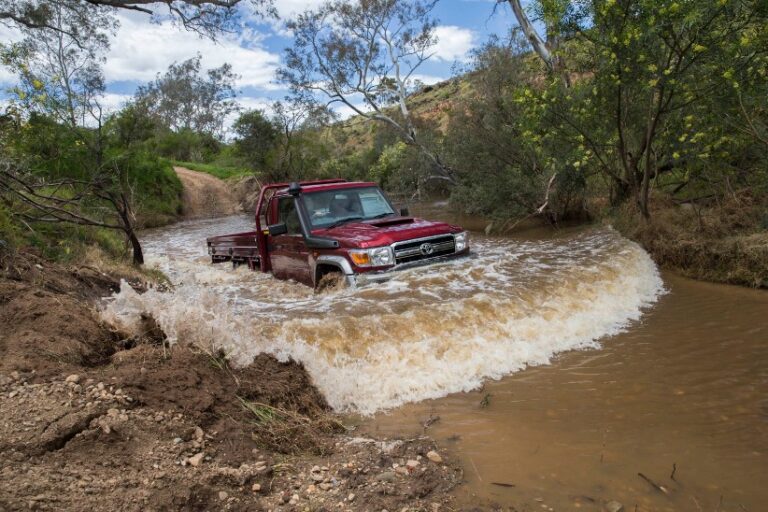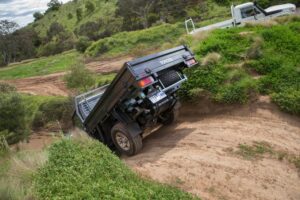– By David Brown –
The Toyota LandCruiser 70 Series is a work horse.
It is rugged, basic and expensive but it is loved by fleet markets especially in the areas of construction, mining and farming as well as a wide range of individual trade operations. Some 62% of the vehicle are sold to fleets. Sales to the private market include the serious grey nomads and others who seek travel adventure.
Toyota reliability as well as a dealer network that extends throughout the rural regions are all part of customer confidence. It is a small, specialist market. Toyota sells only about 7,500 in Australia each year and 70,000 world wide.
For this reason there were strong rumours for the last few years that Toyota would cease production. Its main competitor the Land Rover Defender has already gone by the way as has the Nissan Patrol cab chassis.
But Toyota has upgraded the 70 Series with improvements that include safety upgrades, a revised engine, stronger chassis and better gear ratios and so extended its life by at least 5 years.
The range of models include a single cab chassis, double cab chassis, wagon and troop carrier but the biggest sales are in the single cab chassis.
There is just one drive train. A big 4.5 litre V8 diesel engine puts out the relatively modest performance figures of 151 Kw and 430 Nm. The critical thing is that this means the engine is not being greatly stressed which adds to its longevity. Owners often talk about achieving 400,000 to 500,000 km and some even more.
It is only available with a manual gear box but with a solid easy going engine, it’s easy to drive.
All models now get the safety electronics package of vehicle stability control; active traction control; hill-start assist control; brake assist; electronic brake-force distribution; front seatbelt pre-tensioners; and front-passenger seatbelt warning.
For their biggest seller, Toyota have given the single cab-chassis thicker, stronger, more rigid frame, three additional airbags– curtain-shield (two) and driver’s knee (one) making a total of five.
Critically for the fleet market, the result is the cab-chassis model has achieved a five star ANCAP safety rating.
The previous model had closely spaced gear ratios that felt a bit like a truck but the new five speed gear box has taller gears that make for quieter touring and better fuel consumption. However six speeds would have been better.
The workhorse nature of this vehicle is clearly shown in its towing capacity (3.5 tonnes) and its pay load capacity (at least 1,200 kg depending on the model). The critical thing is that the 70 series can take the maximum in each of these areas at the same time. If you are towing at capacity with other utes, you usually have to be very restrictive on how much payload you add in the tray and vice-versa. With the LandCruiser it is not an either/or situation.
The 70 series concentrates on functionality not comfort features. Air-conditioning is an optional extra, there is no large screen in the centre of the dash board for controlling all the electronics and to adjust the rear vision mirrors you have to reach outside and do it by hand. Only the top of the line model comes with electric windows.
There can be some method in this madness. The air-conditioning is fitted at the dealership and not making it standard keeps the retail price a little lower. Furthermore, its ability to go through deep water means that the lack of electronics in the door is quite understandable.
Consistent with its work ethic the new LandCruiser 70 series has not done much to update its looks apart from a bulge in the bonnet to help cooling and improve pedestrian safety. The bonnet can have more “give” in it if a pedestrian is thrown up onto the car but as most 70 series will probably have bull bars this safety feature is somewhat negated.
I drove a range of the vehicles at the Melbourne 4×4 Training and Proving Ground. It handled the full range of creek crossings, rutted tracks, steep hills and muddy roads with competence and relative ease.
But this all comes at a price.
The base model single cab (the WorkMate) is listed at $62,490 but by the time you add on $2,751 for air-conditioning (which nearly 100% of buyers do), a tray for the back that starts at $2,800 and statutory charges and dealers fees, it’s hard to see you getting much change from $75,000. Fleet discounts can of course be negotiated.
To get the up market version, the GXL, you add another $4,000 plus any changes to on road costs.
The longevity of the vehicle makes for good resale values but it often means that the new car sales are restricted because owners are not rushed to trade up to the new vehicle.
Owners of the Toyota LandCruiser 70 series usually love them, taking all their basic features and looks as a badge of honour for achieving the desired performance.







